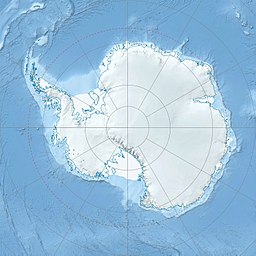The Ace Lake is a 9 metres (30 ft) deep salt water lake on the Ingrid-Christensen coast of the Princess Elisabeth land in East Antarctica. The lake is located on the Langnes peninsula in the Vestfold Hills near the Organic Lake.
| Ace Lake | |
|---|---|
| Location | Princess Elizabeth Land, East Antarctica |
| Coordinates | 68°28′19″S 78°11′16″E / 68.47181°S 78.18781°E |
| Max. depth | 9 metres (30 ft) |
| Surface elevation | 8.8 metres (29 ft) |
Australian biologists at Davis Station explored the lake in 1974 after searching for a saltwater lake with copepods for nine months. The researchers interpreted their discovery as ace, which gave the lake its name. Between 2004 and 2005 a mountain hut was built on the shores of the lake.
In 2013, Zhou et al. discovered a new virophage species by metagenomical analysis, the Ace-Lake-Mavirus (ALM), similar to a short time ago in Organic Lake (OLV) and also in Yellowstone Lake (YSLV). ALM belongs to the virophage genus Mavirus; as a virophage, it is a satellite virus that (as a parasite), when co-infected with a helper virus (host), impairs its ability to replicate. ALV presumably parasitizes species of the Mimiviridae virus family.[1]
Literature
edit- John Stewart: Antarctica – An Encyclopedia. Bd. 1, McFarland & Co., Jefferson and London 2011, ISBN 978-0-7864-3590-6, p. 4
External links
editReferences
edit- ^ J. Zhou, W. Zhang, S. Yan, J. Xiao, Y. Zhang, B. Li, Y. Pan, Y. Wang: Diversity of virophages in metagenomic data sets. In: Journal of Virology. Volume 87, number 8, April 2013, p. 4225–4236, doi:10.1128/JVI.03398-12, PMID 23408616, PMC 3624350.
